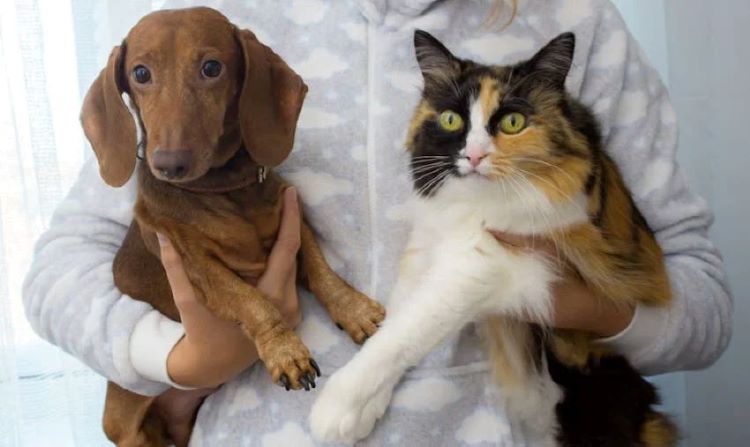Ready to help treat your pet to a healthy life?
How to Introduce a Dog to a Cat
By : Kelli Rascoe & Trupanion Staff | Updated Nov 8, 2024

Everyone should feel comfortable and happy in their home, and this includes your pets. But whether you’re already a multi-pet household or are introducing new animals for the first time, keeping the peace between dogs and cats can seem like an impossible task. Fortunately, there are steps you can take to introduce a dog to a cat safely and promote friendship between all your furry family members.
Read on to learn about cat and dog interactions as well as the best practices for a healthy and harmonious multi-pet home.
Can dogs and cats get along?
Plenty of dogs and cats live together, but can they actually get along or — gasp! — become friends? Centuries-old stereotypes would have us believe that dogs and cats are mortal enemies, but the evidence suggests otherwise.
One study of 200 households with cats and dogs found that 65% of the animals had positive relationships with each other. Common behaviors observed were playing together, sharing water bowls, and even cuddling together for naptime.
Obviously, these friendly scenarios are a dream come true for people who love both cats and dogs and don’t want to have to choose between them.

5 steps to safely introduce dogs and cats
Whether you’re bringing a cat into a dog home or vice versa, following these simple steps will help set you and your pets up for success.
1. Keep pets separated at first
When you bring a new pet home, it’s important for them to get used to the environment first before interacting with other animals. This means keeping dogs and cats separated while the new pet can adjust. According to Trupanion veterinarian Dr. Sarah Nold, it often makes more sense to keep cats confined to one room or area of the house whether they’re the new pet or not.
“For the first 1-2 weeks, keep your cat isolated in their own room with free access to food, water and a litter box,” Nold says. “Make sure it’s a space that your dog can be kept out of and will not cause a lot of inconvenience to your family. This also allows pets to get used to the smell and sound of each other underneath the door.”
2. Go slowly
Since this may be a new experience for all involved, it’s important for pets to have plenty of time for adjustment. Nold advises that the best way to introduce cats and dogs is to go slowly and not rush interactions.
“Let your cat out with your dog on the leash. Let the cat come to the dog and start the interaction,” she says.
Naturally, these introductory steps may have to be repeated for your pets to become used to one another. It’s a safe way for your pets to interact, get to know one another, and play in a common space.
3. Be mindful of different cat and dog behaviors
While introducing a dog to a cat, it’s important recognize that each party may react differently. One study of 748 mixed-pet homes found that cats were more often observed to be uncomfortable around dogs or attack their canine counterparts than vice versa. At the same time, dog attacks on cats may be more severe when they do occur, though starting puppy training early can help prevent this.
With these things in mind, always keep a close eye on both pets throughout the interaction. Never leave pets alone while they’re still getting to know each other, even if things appear to be going well.
“Your cat may hiss or swat. That’s okay, they’re teaching each other boundaries,” Nold explains. “Also, your dog may bark or jump, just keep a tight grip on the leash. Consider allowing 30-60 minutes time frame for your cat to wander and then put them back in their space.”
4. Take breaks as needed
Don’t hesitate to remove the new pet from the space and take a break if you spot signs of trouble. Just like human relationships, pet friendships must be built on mutual trust. Furthermore, there are many factors like breed, age and species that may play a role. Consider providing separate safe spaces with beds, crates and toys to retreat to so they may feel happy while they are learning to interact and adapt to their new family member.
5. Check in with your veterinarian
It’s a good idea to consult with your veterinarian when introducing a new pet to your home. Dogs and cats come in a wide range of personalities, and different tactics may work better for certain breeds and ages. As an animal expert who works with both dogs and cats, your veterinarian will be able to advise you further on safe and healthy introductions.
On that note, you’ll also want to consider pet insurance for both dogs and cats to help protect them from unexpected incidents. With Trupanion, you can even enroll multiple pets at the same time.

Dog and cat friendship takes time
Not all dogs and cats will be best friends immediately. Many will need extra time to grow accustomed to a furry family member. That is completely normal. There may also be cases when one pet will take to the new friend while the other needs more time.
“If the dog doesn’t react and the cat is okay with the dog you’re good,” Nold says. “If they’re still having a spicy interaction continue to increase the interaction times until they are together all the time.”
It’s also normal for some pets to never fully warm up to each other. Nevertheless, by having patience and giving your pets the chance to get to know one another by offering a safe space, you can help them learn to live under the same roof.
Already have a cat but looking to add a canine friend? Learn which dog breeds get along well with cats naturally!
